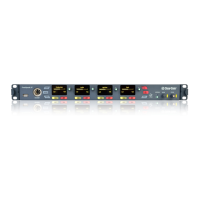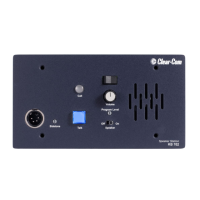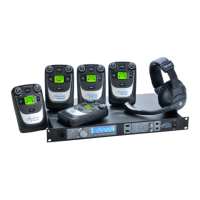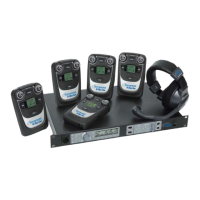Clear-Com Communication Systems
ICS-102/62 Intercom Panel Instruction Manual
1-3
LISTEN LEVEL ADJUSTMENT
The level of any active listen path can be adjusted individually. Refer to
“Listen-Level Mode” later in this chapter.
TALK/LISTEN SELECTORS AND INDICA-
TORS
The following section describes the operation of the talk/listen
selectors and their associated indicators.
SELECTOR OPERATION
The selectors operate as both talk and listen selectors; they also work
as volume controls when the panel is in listen-level mode (see “Listen
Level Mode” later in this chapter). Pressing a selector down accesses
a talk label; pushing it up accesses a listen label. Pushing the talk
selector down and quickly releasing it will “latch” the selector and the
talk path will stay active until it is pressed again. Pressing and holding
a talk selector causes the talk path to stay active only for as long as it is
held down. Listen selectors operate in the same manner.
To prevent the selector on the panel from latching in the talk position
(local latch disable), or to prevent any panel from latching a talk to the
panel (global latch disable) use the configuration program.
TALK AND LISTEN INDICATORS
When a talk path is active, the red LED above the selector lights
continuously. When a listen path is active, the green LED above the
selector lights continuously.
MONITORING/EAVESDROPPING INDICATORS
If any other panel begins monitoring a panel, a beep (the
monitoring-alert tone) will sound at the panel.
To inhibit the monitoring-alert tone, use the configuration program.
CALL-WAITING INDICATOR
If a panel calls another panel with a selector programmed for that label,
the LED will rapidly flash red. This flashing is a call-waiting tally. To
answer the incoming call, push the indicated talk selector. The
call-waiting tally clears when the call is answered, or after the call is
terminated and the answer-back time-out lapses.
If another panel calls a panel without a button programmed for that
label, it will be placed in the answer-back stack (see “Removing Labels
from the Answer-Back Stack”).
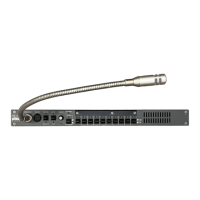
